

is Harmful
Acknowledgements
ENGLISH IVY
Hedera helix
Hedera is the Latin word for ivy;
helix means winding around.
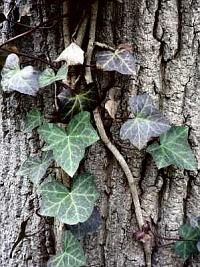


Identification
Look-Alikes
Why English Ivy
is Harmful Removing English Ivy
Notes of Interest
References &
Acknowledgements |
ENGLISH IVY
|

|
Five trees with ivy between Wayne and Colesville, May 2003
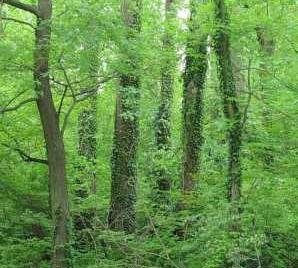
|
A situation where ivy will soon grow on the tree
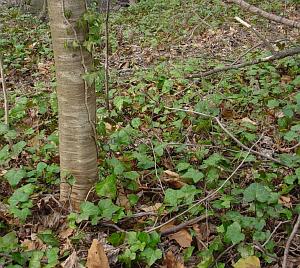
|
English ivy in Sligo only recently developed mature fruiting foliage on a large number of trees, as far as observed by the writer. Fruiting is a serious situation. Many seedling plants can now be expected, and to prevent ivy from reaching disconnected places it is important to stop tree growth soon.
For a progress report of ivy removed in each section, click here.
An outstanding presentation on removal techniques has been created in a Power Point presentation by the Ivy Removal Project in Oregon. For any one anticipating removing ivy from more than a couple of trees, either on home grounds or Sligo woods, the presentation on technique is a must-see www.noivyleague.com/Pages/control_methods.html. A minute or so is needed for downloading. One comes to understand, incidentally, that the ivy situation in Oregon and Washington is kudzu-like in importance, and the information on their website came from hard-won experience. It was in the late 1980s that ivy was noticed there in urban forests and natural areas.
It is possible to get poison ivy in winter by brushing against the twigs, and poison ivy is often present in Sligo where English ivy grows. Every ivy remover should learn to recognize poison ivy in all seasons.
The sap of English ivy causes a skin rash in a few people.
As always with plant work, ivy workers should tackle trees along a path systematically, to avoid others having to make repeated searches for uncut ivy.
All methods of removing ivy have their drawbacks. In short, pulling is labor-intensive, and herbicides have mixed reports of success because the leaves have a water-resistant surface which requires a second chemical to make the first adhere.
Bring: pruning shears (clippers), a pruning saw (folding types are easy to carry in pockets), a sturdy screw driver, and gloves. Protective goggles are suggested for those who do not wear glasses.
Method: The goal is to cut stems as close to the base as is comfortable to delay return growth.
To prevent stems from knitting together, cut in two places and remove the in-between piece.
Pull back stems leading to ivy on the ground if they come readily, to slow down the return of growth.
Do not pull ivy off the bark. The rootlets cling to the bark with a glue-like substance (North Carolina State University website), and pulling may damage the bark, exposing it to invading organisms. And worse for the puller, a beehive or bird nest might come down.
Cut all stems at ankle height and at least a few inches higher, using loppers or a pruning saw. Strip the cut sections from the tree to prevent reconnecting.
Botanist John Parrish writes, "I use an iron pry bar with a flattened end to pry away thick ivy vines from the tree bark. Do not wound the bark. On thin barked trees, be careful to buffer the pivoting point of the pry bar with an old rag or a thin piece of wood. Next I cut the vines with loppers or pruners. Sometimes I use a small handsaw called a pruning saw to cut away thick vines. You just have to be careful to NOT cut into the living green inner bark. Thick bark trees can be cut into to some extent without harming the inner living tissue. Each tree is different and requires its own careful tending."
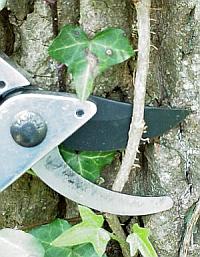
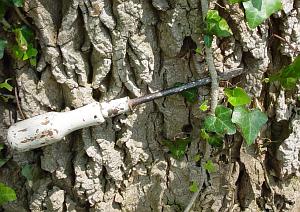
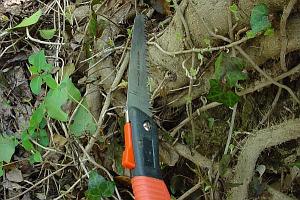
Disposal: Leave the vines in loose piles to dry. The vines almost never take root again, and if they should, you can get them at a later time. This allows minerals to be recycled.
Return in 6-12 months to get ivy inevitably rising from roots left in the ground, or appearing from seeds.
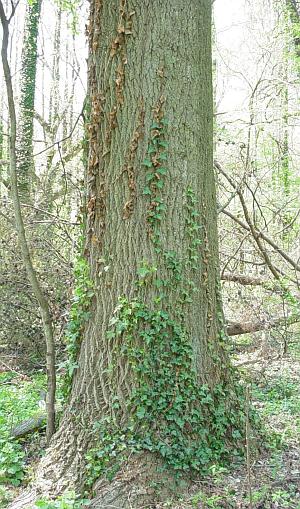 Cutting ivy stems on trees is a stopgap measure. They will have to be cut again until all ivy on the ground is also removed. Cutting should always be at the base, unlike the attempt here, to give more time before the ivy needs recutting.
Cutting ivy stems on trees is a stopgap measure. They will have to be cut again until all ivy on the ground is also removed. Cutting should always be at the base, unlike the attempt here, to give more time before the ivy needs recutting.
It is Park policy not to remove ivy or any other plants from the stream banks. Friends of Sligo Creek is in strong agreement Bank erosion is far more serious than the presence of a few undesirable plants that can be removed when we have studied the problem more carefully.
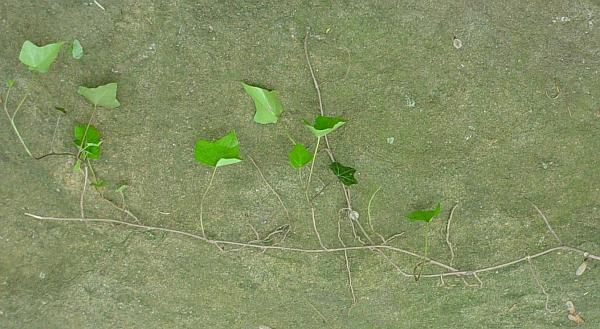
Carole Bergmann writes on the Maryland Invasive Species Council website that the best way to remove ivy manually is to cut the ivy roots, then "roll the vines, much like rolling up a giant carpet." This is a technique the writer has not yet seen and would like to try. It is illustrated in the Ivy Removal Project Power Point show.
On steep slopes removing ivy could cause erosion, although John Parrish feels it is unlikely in most places. Check with Carole or Sally before removing from steeper areas. Save the ground pulling for September and October so that autumn leaves will soon cover bare spots with leaf litter. At some sites we may need to have native plants ready to fill in bare spots.
An eight-inch blanket of mulch laid over ivy is reported to kill it. Mulch would also prevent other seeds in the seed bank from sprouting, defeating part of our purpose in the park. But mulch might be useful in a back yard.
Of interest but probably impractical and not needed here is a technique described as the cookie-cutter approach, tried in the Northwest. Cut a circle three feet in diameter and remove the ivy. Plant a tree in the center of the circle. Mulch the circle with wood chips. In six months, remove ivy growing into the circle. Cut new circles. Increase the size of all circles as the trees get established. After a second year, add an herb layer, ferns, and shrubs.
Websites offer contradictory information on the effectiveness of herbicides. A second chemical used to make the first adhere puts an unpleasant odor into the air. Any chemical not applied in winter may damage other plants. A chemical designed for stems could permeate a tree with thin bark. For home use where hand pulling cannot be considered, several websites should be compared.
The University of Minnesota website reports that "a fungus (Phoma hedericola) has been damaging a population of H. helix in Italy and may be a potential candidate as an introduced biological control (Franco et al., 1992). It has also been speculated that introducing a biological control is extremely unlikely due to the importance of Hedera helix as a landscape plant and support it receives from the American Ivy Society (Reichard, 2000)".